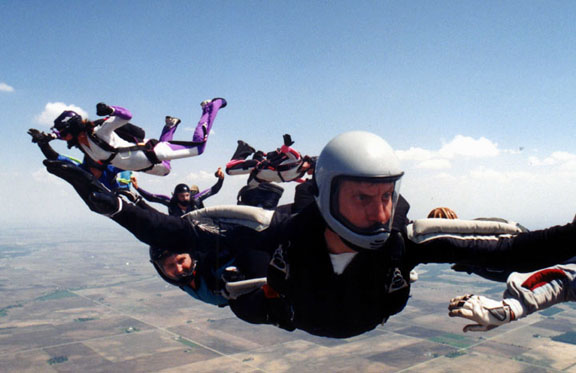
(1)

(1)
When you leave the aircraft, you are moving horizontally at the same speed as the aircraft, typically 90-110MPH. During the first 10 seconds, a skydiver accelerates up to about 115-130MPH straight down. (A tandem pair uses a drouge chute to keep them from falling much faster than this). It is possible to change your body position to vary your rate of fall. In a standard face-to-earth position, you can change your fall rate up or down a few (10-20) miles per hour. However, by diving or "standing up" in freefall, any experienced skydiver can learn to reach speeds of over 160-180MPH. Speeds of over 200MPH require significant practice to achieve. The record freefall speed, done without any special equipment, is 321MPH. Obviously, it is desirable to slow back down to 110MPH before parachute opening. (2)
Once under parachute, decent rates of 1000ft./min. are typical. A lighter student with a bigger canopy may come down much more slowly, and, obviously, a heavier person may have a somewhat faster decent. Experienced jumper's can canopies descend (in normal glide) at up to 1500ft./min. During radical turns, the decent rate can go well over 2000ft./min.(2)
A person has a terminal velocity of about 200 mph when balled up and about 125 mph with arms and feet fully extended to catch the wind (4)
The force of drag is calculated using the formula:
![]() (6)
(6)
where CD
= the coefficient of drag
p = the density of the fluid
v = velocity of moving object
A= cross-sectional area of object parallel with movement
Drag varies from person to person, due to the size, velocity, and clothing worn. As you can see by looking at the velocities of the skydivers the drag force is much larger when the parachute is opened due to the larger cross-sectional area of the parachute.
Take a look at all of the objects on the skydiver-parachute
system that cause drag:

(7)